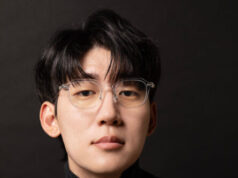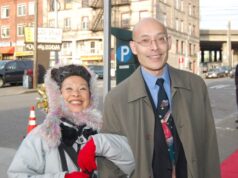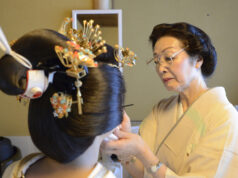Kazuhiro Kawasaki, Professor Emeritus The Evergreen State College
By Keiko Miyako Schlegel NAP Contributor
Translated by Bruce Rutledge NAP General Manager
 ▲These are two paintings created during his university years. The one on the right is from his first year, and the one on the left is from his final year of university. Photo credit: Kazuhiro Kawasaki.
▲These are two paintings created during his university years. The one on the right is from his first year, and the one on the left is from his final year of university. Photo credit: Kazuhiro Kawasaki.
 Shortly after changing his major in California, he dressed in the fashion of the time (1970). Photo credit: Kazuhiro Kawasaki. ▶︎
Shortly after changing his major in California, he dressed in the fashion of the time (1970). Photo credit: Kazuhiro Kawasaki. ▶︎
It is has been 60 years since he crossed the ocean at the age of 22 to become a painter. Once drawn to avant-garde (experimental genre) art, the young man became an art historian. Now, 20 years after leaving teaching, he has found a new way to enjoy life. Kazuhiro Kawasaki speaks with an insatiable passion for beauty, peppering his speech with the occasional English word. His gentle smile belies his deep passion for art.
Kawasaki’s home is neatly lined with paintings he has collected over the past 40 years. The artwork, which vary in period and style, include powerful abstract paintings, delicate lithographs by French artists, pop art (traditions in fine art challenged by including imagery from popular and mass culture), works by friends and former students, ukiyo-e prints (woodblock prints from 17-18th century), and even a bamboo vase made by a Japanese artist in the U.S. which is his favorite. The living room is a great place for reading and relaxing. While reading in the living room, he has a conversation with an abstract painting that hangs in front of the sofa.
Kawasaki was diagnosed with color blindness at age five. For therapy, a student from the art department of Miyazaki University Japan was hired to play with Kawasaki to familiarize him with colors. Kawasaki’s gift upon entering elementary school was a set of crayons. At lunchtime, instead of going to the schoolyard with other kids, Kawaski stayed in the classroom drawing pictures of trees and rivers with crayons. In the sixth grade, Kawasaki was one of five children throughout Japan whose art was featured at exhibitions in Okinawa and Hong Kong.
Kawasaki’s first encounter with avant-garde art was in 1961 when Tokyo was preparing to host the Olympics Games. “There was something exciting about the free and futuristic expression,“ he says. He entered Kyushu University School of Medicine in Japan but dropped out within three months. In an anatomy class, he took a scalpel to an anesthetized rabbit and fainted when he saw it twitch. Kawasaki felt too ashamed to face his parents so he headed to Tokyo. He befriended a group that was living in a converted warehouse in Fukagawa in downtown Tokyo and moved in with them. These new friends were avant-garde art devotees. Kawasaki was inspired. Tokyo was an interesting place at the time. Even in Japan, the avant-garde art movements known as neo-Dada (playfulness after the controversial assemblage of the Dada movement) and Fluxus (experimental art performances) were flourishing. At a solo exhibition held in a room rented at the Imperial Hotel in Japan, copies of Japanese money were pasted all over the room. Although it is illegal to copy bills, “that is the nature of avant-garde art,“ Kawasaki said with a smile.
During his time in Tokyo, Kawasaki lived a poor but fulfilling life working at various jobs and as an illustrator for a clothing designer. One day, he received a letter from his father. “I suppose you are not doing much in Tokyo,” his father wrote. “An American friend of mine from long ago is visiting Japan for a business meeting and I want you to go with him.” “It was an order from my father,” Kawasaki said. “I had no reason to refuse since I would be paid for my services.” When Kawasaki told the American business man that he really wanted to become a painter, the man told him he could study painting in Seattle. In 1965, Kawasaki boarded a British cruise ship and left for Seattle via Vancouver, British Columbia at the age of 22.
After one year of study at Shoreline Community College in Seattle, Kawasaki transferred to the University of Washington in Seattle. He decided to become an oil painter. He painted diligently and his skills improved considerably but something was missing. In his fourth year of college, Kawasaki put down his paintbrush. He found it unbearable to even smell the paint anymore.
Once again, Kawaski was disappointed and lost. He headed to San Francisco, California, to heal his heart. The day after his arrival, he met two women at a coffee shop who offered him a place in their attic in exchange for cleaning and cooking services. In his spare time, Kawasaki returned to painting again but this time he painted whatever he liked. He had no regard for deadlines or what others thought of him. “I was never happier,” he says. After three months, Kawasaki returned to the university and changed his major to Art History. From there, he worked as an art historian focusing on literati paintings. At the age of 34, he took a job at The Evergreen State College and devoted himself to teaching.
When Kawasaki taught art to his students, he was most concerned about making them understand the essence of “ambiguity.” “It is difficult to translate into Japanese but ambiguity is not the same as leaving something vague. Ambiguity is the exact opposite. It is something that is reached as a result of pursuing phenomena that do not have clear answers. “I want my students to find out for themselves why they are drawn to particular paintings. Art reflects religion, politics, economics, and everything else of its time,” he says. The world in which the artist lived and the artist’s own humanity are reflected in the work and it is from this perspective that we look at ourselves through the paintings. ”Look at yourself as you are at that moment. That is the answer and the essence of art,” Kawaski says. The confrontation between the painting and the viewer also continues. Why is the Mona Lisa a masterpiece? In Kawasaki’s view, over the course of 500 years many people have been moved by the painting, and their feelings have been absorbed into the painting and become a part of it.
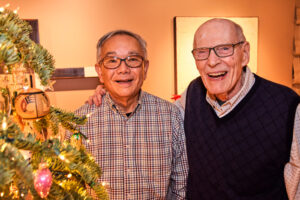
▲Christmas at home with Bill (2018). Photo credit: Kazuhiro Kawasaki.
On the other hand, Kawasaki, in his 20s, gave up his career as a painter because he could not stand the evaluations and stares of others. “When I was young, I was very critical of myself. Even after becoming a scholar, I was always concerned about the impact I had on others,“ he says. Kawasaki, now in his 80s, is free from such inner conflict. He paints what he likes without worrying about what anyone else thinks. A few years ago, he also began learning botanical art.
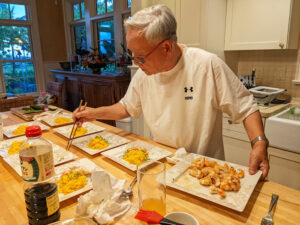
▲Boasting about his cooking skills during a stay in Hawaii (2022). Photo credit: Kazuhiro Kawasaki.
Kawasaki lived an independent life. He met a bank employee in his mid-30s named Bill and spent the rest of his life with him. They loved the arts and traveled the world. Forty years have elapsed and in 2021, Bill passed away after a battle with an illness. Bill’s adult sons invited Kawasaki to an online botanical art class to cheer him up. In the past, his abstract paintings expressed his individuality but botanical art was a stricter medium. Kawasaki’s rebellious spirit emerged and he was chastised by the instructor for emphasizing shadows that were not really there. “I would like to understand where my sense of beauty comes from,“ he says. There are still many things he would like to do. Kawasaki’s eyes are still filled with the spirit of a young boy.

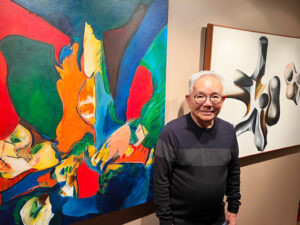 ▲These are two paintings created during his university years. The one on the right is from his first year, and the one on the left is from his final year of university. Photo credit: Kazuhiro Kawasaki.
▲These are two paintings created during his university years. The one on the right is from his first year, and the one on the left is from his final year of university. Photo credit: Kazuhiro Kawasaki.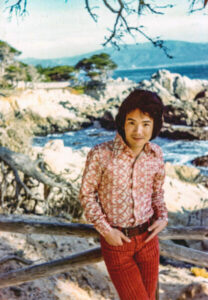 Shortly after changing his major in California, he dressed in the fashion of the time (1970). Photo credit: Kazuhiro Kawasaki. ▶︎
Shortly after changing his major in California, he dressed in the fashion of the time (1970). Photo credit: Kazuhiro Kawasaki. ▶︎